Key takeaways:
- Understanding venue capacity is crucial for creating a comfortable and enjoyable atmosphere at events.
- Effective crowd management strategies, such as flexible seating plans and staggered entry times, can enhance guest interactions.
- Utilizing planning tools and real-time analytics helps in effectively managing guest counts and layouts.
- Always accommodate for unexpected guests and assess venue layouts to avoid potential capacity issues.
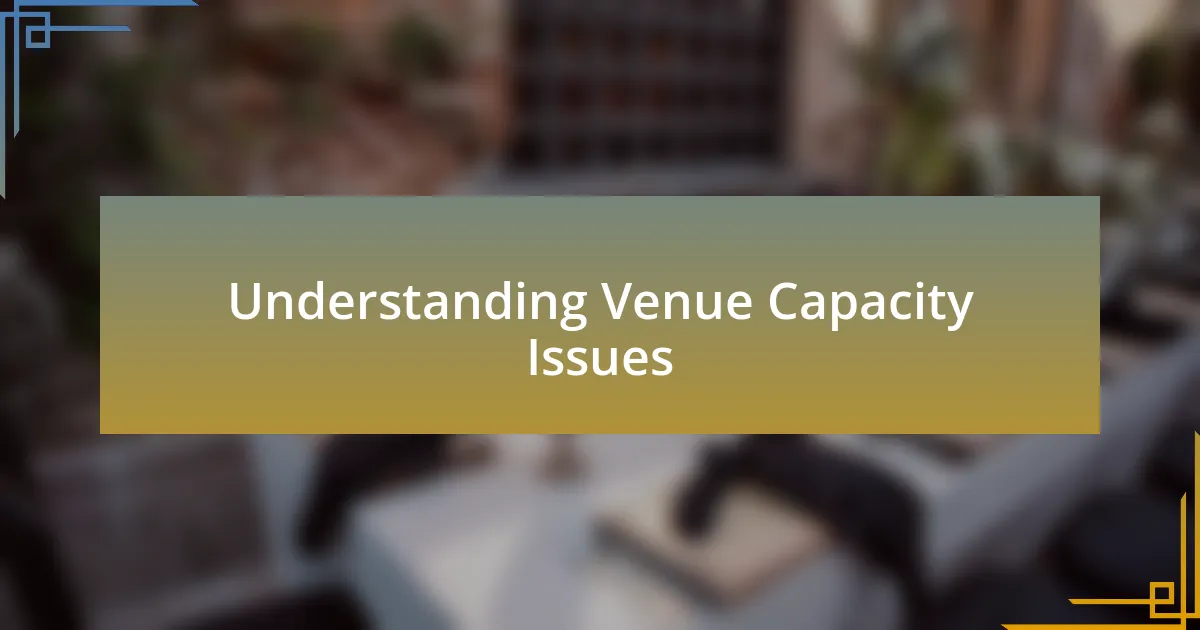
Understanding Venue Capacity Issues
When it comes to venue capacity, understanding the limits of space can make or break your wedding plans. I remember attending a friend’s wedding where the venue felt cramped due to underestimated guest counts, and it made me realize how crucial it is to get this right. Have you ever been in a situation where a venue felt either too intimate or overwhelmingly spacious?
It’s easy to think of capacity as just numbers, but it encompasses much more. I’ve witnessed how layout and design impact the flow of guests, making the difference between a cozy gathering and a chaotic crowd. For example, at my own wedding, we chose a place that seemed perfect on paper, but once we filled it, it was a tight squeeze; this taught me the importance of visualizing the space and anticipating movement.
Capacity doesn’t just influence comfort; it can shape the atmosphere of your entire event. I recall the vibrant energy of a close friend’s wedding, where the venue buzzed with laughter and joy, perfectly fitting the guests. Aren’t we all looking to create that sense of connection and celebration? Understanding how to balance capacity with your vision is key to crafting the experience you and your loved ones will cherish.
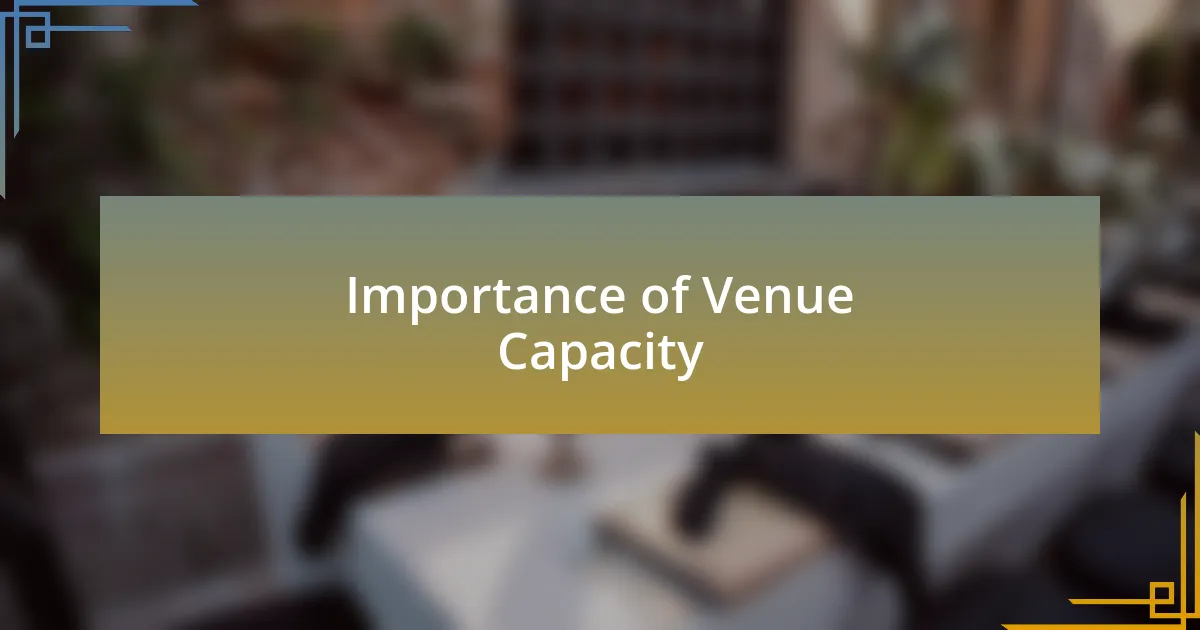
Importance of Venue Capacity
When choosing a venue, capacity isn’t just a matter of fitting everyone in; it truly impacts the overall experience. I remember a wedding I attended where the venue was beautifully ornate but far too large for the guest list. The empty spaces felt awkward, and it took away from the connection among guests. Have you ever felt a similar disconnection at an event?
The right venue capacity fosters an intimate environment, allowing conversations to flow naturally. In my experience, during my cousin’s wedding, the room was filled to just the right level, filling it with laughter and chatter without the suffocating pressure of overcrowding. This balance created a warm and inviting atmosphere that made everyone feel embraced by the celebration.
Having the right capacity also speaks to your budget and overall logistics. I once dealt with a situation where a last-minute guest count increase meant scrambling for additional seating and catering. It was stressful, and I learned the hard way that flexibility in planning is essential. When you know your venue’s limits, you can plan confidently, making the day memorable for everyone involved.
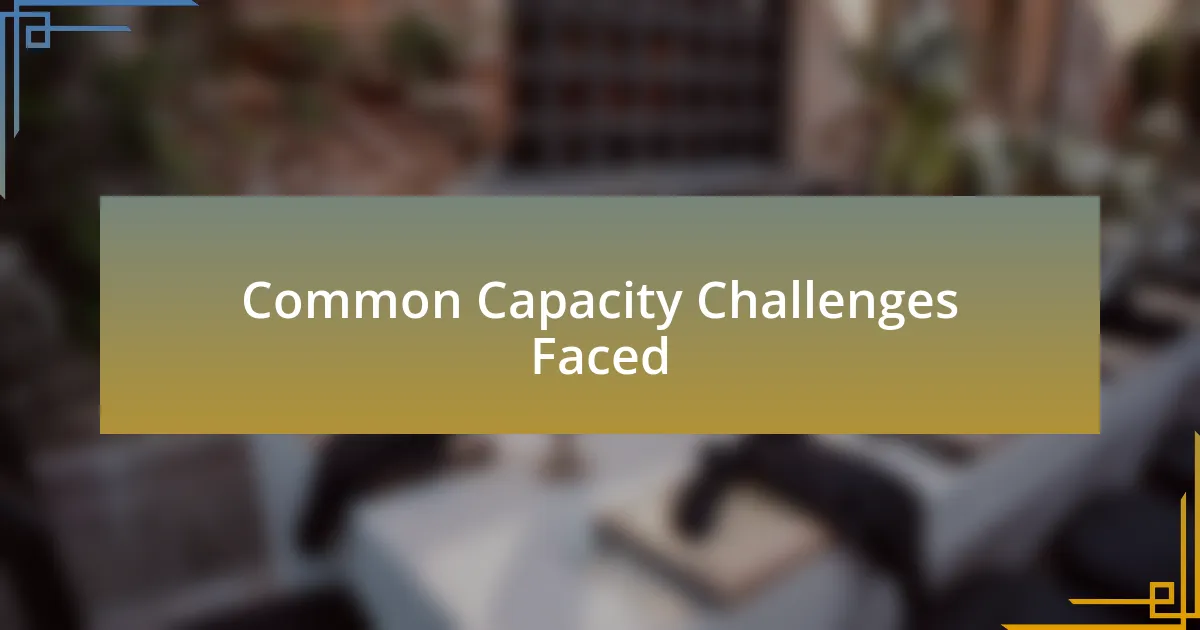
Common Capacity Challenges Faced
Choosing a venue often presents common capacity challenges that can significantly affect the event. At one wedding I coordinated, we faced an unexpected increase in attendees just a week before the big day. We had to quickly rearrange the seating chart and negotiate with the venue staff about available space, which was quite nerve-racking. Have you ever felt that rush of panic when your plans suddenly shift?
Another frequent issue is the mismatch between the venue’s layout and the intended guest experience. There was a time when I attended a wedding held in a large hall that, while elegant, was not conducive to mingling. Guests were scattered across tables, and I could see how difficult it was for couples to engage with one another. The atmosphere felt diluted, and it made me realize that the physical setup plays a vital role in creating connections.
Additionally, I often remind couples that the wedding season can lead to capacity constraints, especially in popular venues. I vividly recall a friend who had her heart set on a specific place, but it was already booked for the date she wanted due to its popularity. It became a whole search for alternatives, and while it eventually turned out well, it was a lesson on the importance of checking availability and capacity as early as possible. How often do we underestimate the demand for our dream venue?
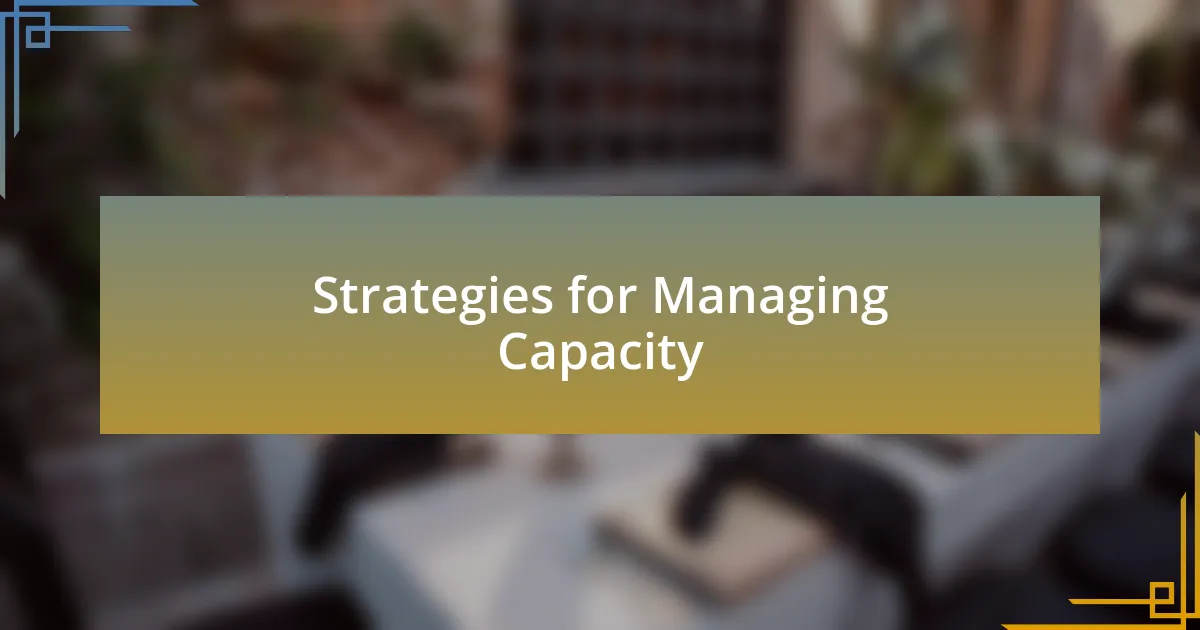
Strategies for Managing Capacity
When managing venue capacity, communication is key. I remember a wedding where we decided to implement a digital RSVP system. This not only streamlined our guest count but also allowed for real-time updates, helping us anticipate fluctuations in attendance. Have you considered how technology can keep you one step ahead?
Another effective strategy I’ve employed is having a flexible seating plan. I once faced a situation where the initial layout fell short due to last-minute guests. By utilizing a combination of round tables and lounge seating, we created an adaptable environment that still felt intimate despite the crowd. Isn’t it fascinating how the arrangement can transform a space?
Finally, I advocate for crowd control measures like staggered entry times or designated zones within the venue. At a recent event, we divided the space into different sections, allowing groups to flow naturally throughout the evening. This not only eased congestion but also encouraged mingling. Have you thought about how to enhance guest interactions simply by guiding their movement?
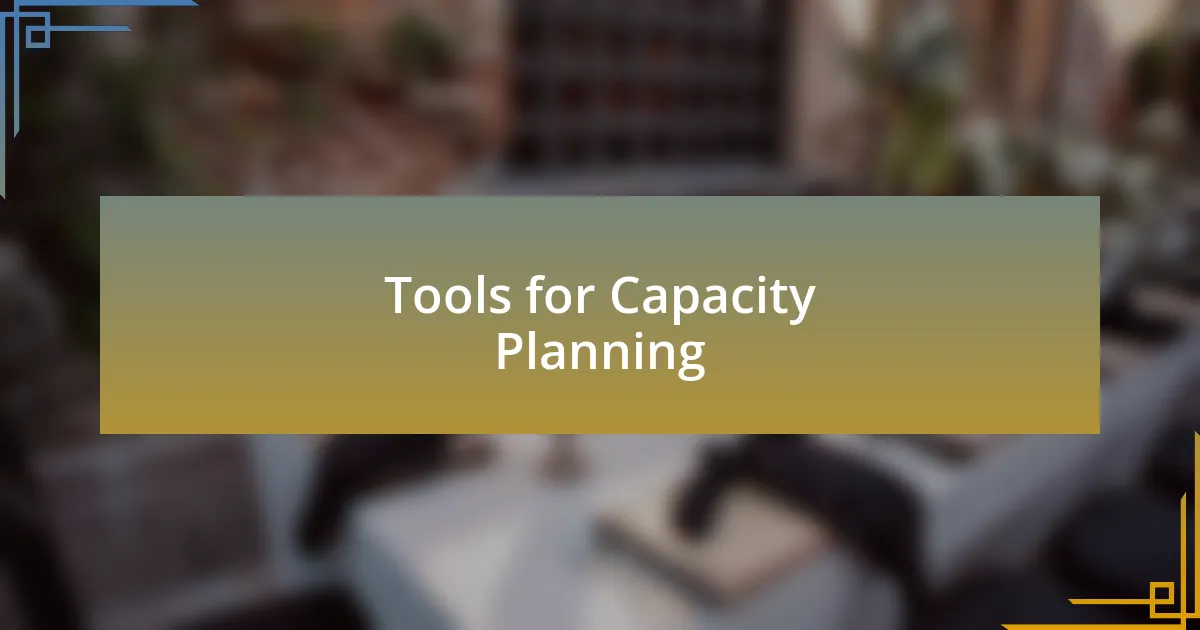
Tools for Capacity Planning
When it comes to capacity planning, I’ve found that using dedicated software tools can be a game changer. For instance, I often rely on platforms like Social Tables, which allows me to visualize the floor plan and play with different configurations. I once used this for a wedding where we had a unique venue shape—I could experiment with layouts, ensuring every guest felt included without overcrowding a single area. Have you tried any layout tools that let you see your vision come to life?
Another handy tool in my arsenal is a guest list management application, like WeddingWire or The Knot. These apps not only help track RSVPs but also provide insights on how many guests are attending from various locations. At a recent wedding, I noticed a significant number of ‘plus-ones,’ which nudged me to reevaluate our seating arrangement late in the planning phase. Have you thought about how these insights might influence your guest experience?
Lastly, I emphasize the importance of real-time analytics. Some event management platforms offer live updates on attendance, which can be invaluable. During one event, I connected to a mobile app that showed how many guests had arrived versus those who had RSVP’d. It gave me the confidence to make quick decisions on accommodating last-minute additions. Isn’t it reassuring to rely on data to guide your planning when the stakes are high?
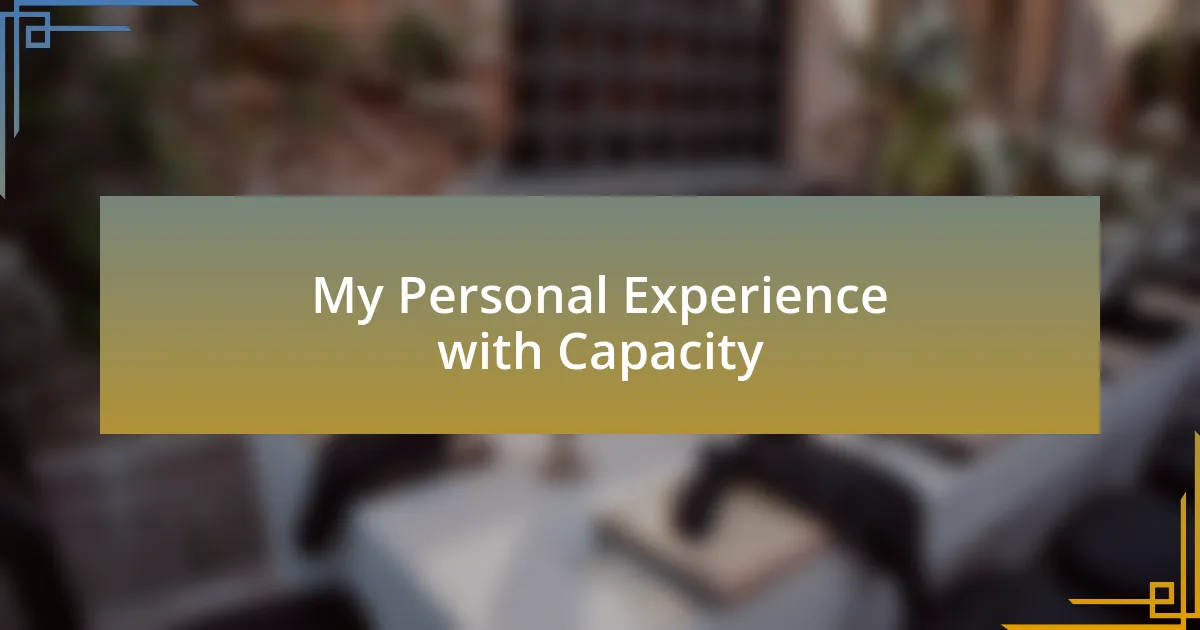
My Personal Experience with Capacity
When I first faced capacity issues, it felt overwhelming. I remember a particularly beautiful outdoor wedding where the invited guests kept growing, and suddenly we were facing a crunch. There’s nothing like the panic of realizing that your carefully curated seating chart can’t accommodate everyone. Have you ever had to make split-second decisions about who might need to sit or stand?
Afterward, I learned the importance of having a buffer when planning guest lists. I always leave room for unexpected plus-ones. At one event, a couple of last-minute attendees showed up, and I had to improvise to ensure everyone had a spot without sacrificing their comfort or the atmosphere. It’s a delicate balance, isn’t it?
Now, I also take time to assess the venue’s layout beforehand, imagining how each guest would flow through the space. This forethought paid off immensely when I planned a wedding with a narrow entrance that could easily become congested. By visualizing the movement of guests, I could suggest adjustments to the venue that improved guest experience significantly. It’s funny how a little planning can turn potential chaos into a memorable celebration, right?